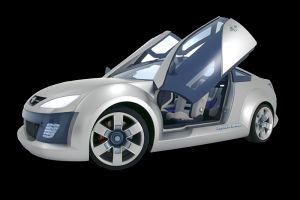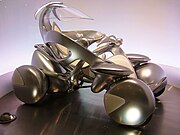The FX-1 was a concept car by Toyota. It was first shown at the 1983 Tokyo Motor Show and also shown at the Geneva Motor Show in March 1984. It was a showcase for new technologies in driver controls, engine, suspension, materials and aerodynamics.
Driver Controls
Colour CRT's were used in the dash to display speed, rpm, fuel, temperature, etc.
Engine and Driveline
It used an enhanced prototype form of the 1G-GE engine (1998cc, 6 cylinder, twincams, EFI), a 24-valve twin cam equipped with dual turbo-chargers and intercooler, computer controlled valve timing, variable displacement and induction. At low speeds, the variable displacement system shut down half the engine to conserve fuel. The system never went into production.[1][2]
This engine later appeared as the 1G-GTE, slightly modified for production and without the variable cam timing and variable displacement.
Transmission was via a 4 speed automatic ECT (Electronically Controlled Transmission) with overdrive.
Suspension
It used a pneumatic suspension combined with the TEMS (Toyota Electronically Modulated Suspension system). The pneumatic suspension automatically raised and lowered the front and rear of the car separately for maximum stability. TEMS was also used on the Supra and the Soarer.
Materials
Many exotic materials were used, including Fibre Reinforced Metal (body panels) and Shape Memory Effect Alloy (body panels) and Ceramics (brake rotors).
Aerodynamics
The body had a very low Cd (co-efficient of drag) value of 0.25.
Stability could be increased via aerodynamics by individually lowering the front and rear suspension according to road speed. At high speed the front was lowered two steps and the rear was lowered one step.










![Validate my RSS feed [Valid RSS]](valid-rss-rogers.png)














































































